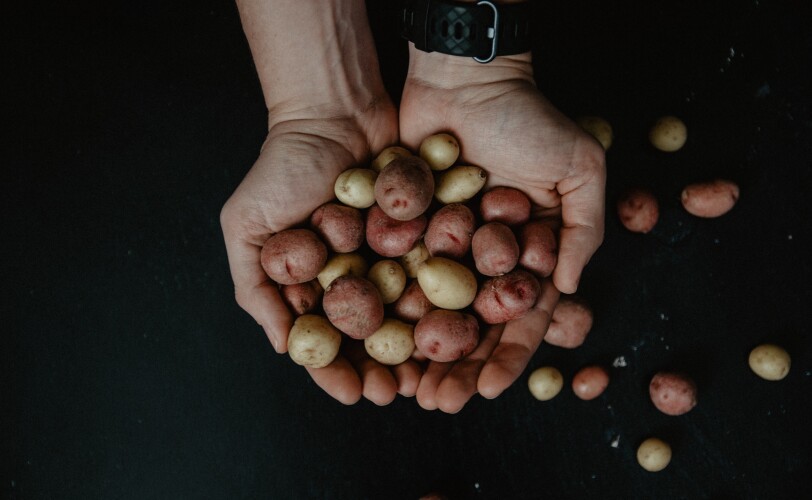What is resistant starch?
Did you know that letting the potatoes cool and reheating them has its benefits? These cooking/cooling/reheating cycles cause the starch to change its molecular form, becoming a type of fibre that will serve as food for the bacteria in our microbiota. This doesn't only work with potatoes; it can be applied to any starch, such as rice, beans, or pasta. The more cycles, the stronger the starch is made.

In other words, resistant starch (RS) is a type of starch that cannot be digested in the small intestine. As a result, it is categorised as a kind of fibre, supplying about two kcal/gram. Resistant starch passes through the small intestine unbroken and is then fermented in the large intestine, making short-chain fatty acids (SCFA) which act as an energy source for colonic cells. Foods that raise the number of SCFAs in the colon are thought to be useful to health by helping to prevent the growth of abnormal cells in the gut.
Types of resistant starch
- Type one resistant starch stays attached to the fibrous cell walls of the food that the person eats. The person cannot digest the fibre or the starch itself. Type one resistant starch is common in seeds, legumes, and many grains.
- Type two resistant starch is more abundant in some raw foods and has a particular structure that makes it difficult for people to digest. For example, a slightly unripe banana would be higher in type two resistant starch than a fully ripe banana.
- Type three resistant starch is a very resistant starch that is produced during the process of heating and then cooling starchy foods. For instance, allowing potatoes or rice to cool down after cooking them will convert some of the starches into highly resistant starch.
- Type four resistant starches are treated and changed forms of starch. These resistant starches are artificial.
- Type five resistant starch is starch that has joined with a type of fat, changing its structure and making it more resistant to digestion.
Benefits;
- When normal starch becomes resistant starch, most of the sugars it contains are not released in the intestine, so the body will absorb fewer calories from the same food.
- There is some evidence that resistant starch can decrease appetite and short-term food intake. Potential mechanisms include a rise in the production of gut hormones which promote feelings of satiety.
- There is some evidence that resistant starch can prevent the damaging effects of high red meat intake on colorectal cancer risk.
- Because less sugar is released into the bloodstream, the blood sugar peak is less noticeable. This reduces insulin levels.
- The resistant starch is indigestible and, therefore, shares many properties with the fibre, which helps the food to pass through the intestine and, in general, improves digestion.
- Once it reaches the small intestine, resistant starch feeds our beneficial bacteria, which at the same time produce chemicals that can help our immune system, cardiovascular health, among other benefits.
How to include resistant starch in your diet
- Try cooking potatoes, rice, beans, and pasta a day in advance and cool in the refrigerator overnight.
- Add lentils or beans to a salad or soup.
- Instead of cooked oatmeal, try uncooked oats soaked in yoghurt, milk, or non-dairy milk and refrigerate overnight (often called overnight oats).
- As a partial flour replacement try green banana flour, plantain flour, cassava flour, or potato starch. You can also supplement with a small amount (one-two teaspoons) sprinkled on your food.
References
1. Studies on the effect of multiple heating/cooling cycles on the resistant starch formation in cereals, legumes, and tubers - https://www.ncbi.nlm.nih.gov/pubmed/19562607?fbclid=IwAR1JuWJO_byYeZIWjWkZNC1zdX6IfKRzZIN1KiKILP1HeU5SJrVHAU5eGEQ
2. Acute ingestion of resistant starch reduces food intake in healthy adults - https://www.ncbi.nlm.nih.gov/pubmed/19857367?fbclid=IwAR29fPU5UzU9BA7ZbJTwzqIV7EP3wyVXKFLMGOAJIEsznFXkGF40kb5UUSI
3. Resistant starch consumption promotes lipid oxidation - https://www.ncbi.nlm.nih.gov/pmc/articles/PMC526391/?fbclid=IwAR0xBJT7eCVLaePF9q2JHfNrZKiQt8r4FU4nqaBWxyUqWc8s_t6f3Yw_iYM

Find the right nutritionist for you
All nutrition professionals are verified